Perfect Etsy Product Photo Size Made Simple
 ProdShot Creator
ProdShot Creator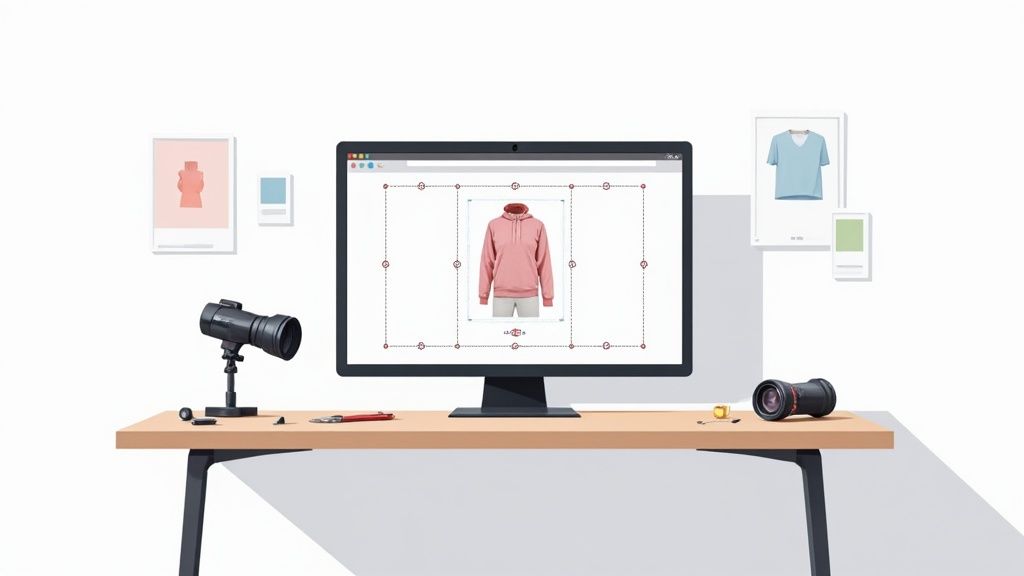
When it comes to the perfect Etsy product photo size, here’s the most important rule of thumb: make your images at least 2000 pixels on the shortest side. This one change is often the fastest way to improve your shop's visual quality. It ensures your pictures look sharp, enables the all-important zoom feature, and, most importantly, builds buyer confidence.
Your Quick Guide to Perfect Etsy Photos
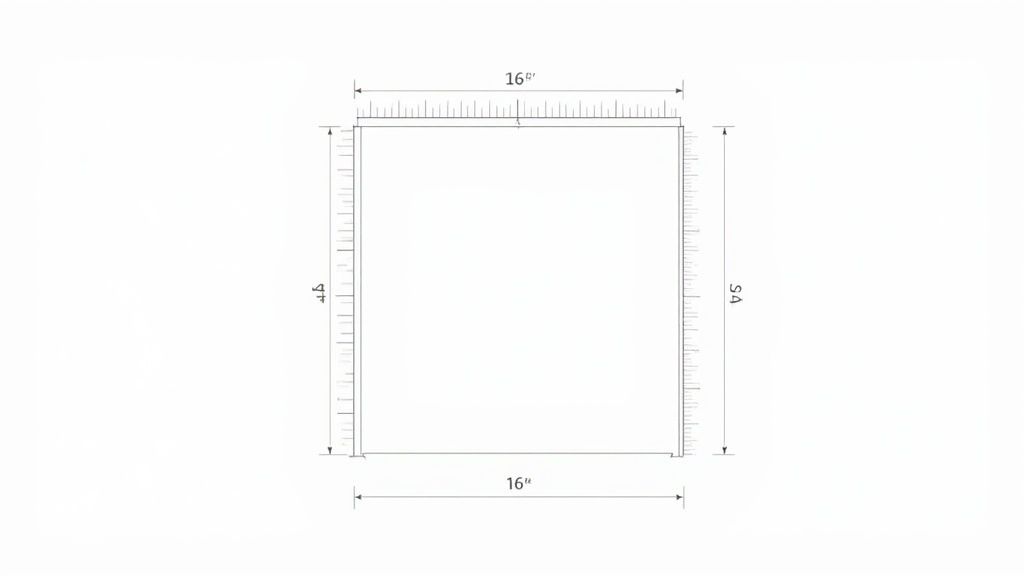
Let's cut right to it. You're a busy seller, and you need the right numbers to make your Etsy products look fantastic without a lot of guesswork. This section is your cheat sheet with all the current recommendations for listing images, thumbnails, and shop banners.
We’ll get into the why behind these numbers later, but for now, think of this as the foundation. We’ve broken down all the key dimensions and file requirements into an easy-to-read table so you can grab what you need and start uploading like a pro.
Etsy Image Size Cheat Sheet
This table is your quick reference for all the important specs. Keep it handy!
| Image Type | Recommended Minimum Size (Pixels) | Recommended Aspect Ratio | Max File Size |
| Listing Image | 2000px on shortest side | 4:3 (horizontal) | Under 1MB (Recommended) |
| Shop Icon | 500px x 500px | 1:1 (square) | Under 1MB (Recommended) |
| Order Receipt Banner | 760px x 100px | 19:2.5 (horizontal) | Under 1MB (Recommended) |
| Mini Shop Banner | 1200px x 160px | 15:2 (horizontal) | Under 1MB (Recommended) |
With these numbers in hand, you’re well on your way to creating a visually stunning and professional-looking shopfront.
Why These Numbers Matter
Etsy’s guidelines are all about giving customers a great experience on any device, from a tiny phone screen to a big desktop monitor. That's why they recommend your main listing photos be at least 2000 pixels wide on the shortest side, with a resolution of 72 PPI. This is what powers that crystal-clear zoom function shoppers rely on to inspect details before they buy.
For the small thumbnails that show up in search results, Etsy automatically resizes them. Starting with a large, high-quality image ensures they still look crisp and clear even when shrunk down. You can upload up to 10 images for each listing, giving you plenty of opportunities to showcase your work. To really elevate your photos, you might explore modern AI image enhancement techniques that can sharpen details and perfect colors with just a few clicks.
Key Insight: Don't think of the 2000-pixel minimum as just another rule. It's a powerful sales tool. High-resolution photos are proven to build customer trust and can directly lead to better conversion rates.
How the Right Photo Size Can Skyrocket Your Sales
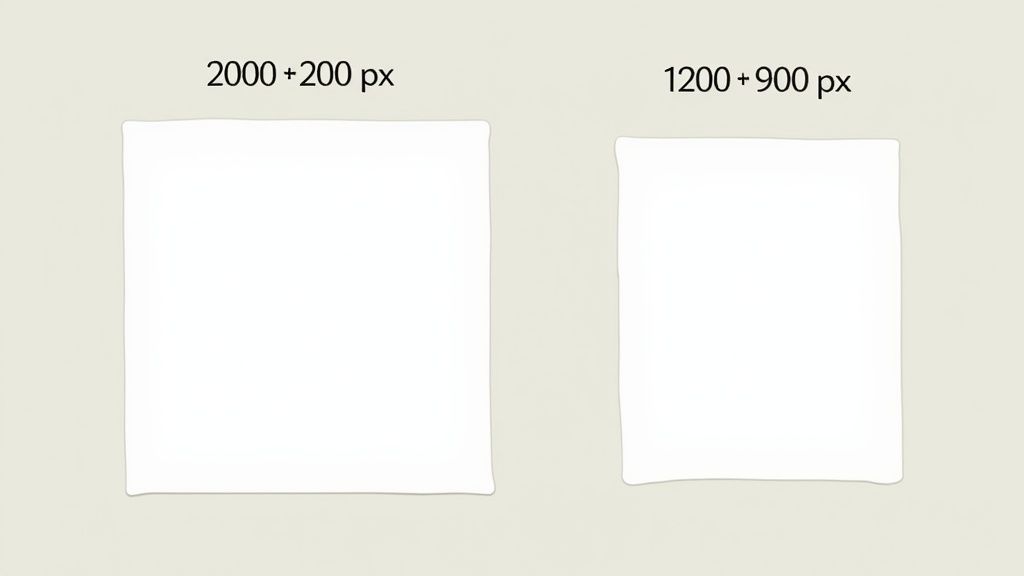
Getting your Etsy product photo size right isn't just about following rules. It’s one of the most powerful sales tools you have. Think about it: high-quality images do more than just display your items; they build a sense of trust and make your products feel real to someone who can't touch them.
Your product photos are essentially your digital storefront window. When a potential customer sees a sharp, clear, and detailed picture, it immediately signals professionalism and quality. It tells them you’re serious about your craft, which in turn makes them confident enough to make a purchase.
Key Takeaway: Your images are your best salesperson. They close the gap between the online screen and your customer's hands, making your product tangible and trustworthy.
A huge, often-overlooked benefit of using the correct photo size is activating Etsy's zoom feature. Shoppers absolutely love to get up close and personal with a product, whether they're examining the texture of a fabric or the delicate clasp on a necklace. If your photos are too small, that zoom function won't work, leaving buyers with questions and doubts.
Turning Browsers Into Buyers
The link between your photo quality and your shop's success is incredibly direct. Great visuals aren't just for looks; they translate into real, measurable growth. In fact, Etsy sellers who use images that are 2000 pixels or more on the shortest side often see a noticeable boost in performance. You can dig into the specifics by exploring the full findings on Outfy.com.
This single change can create a positive ripple effect throughout your shop. Better images lead to:
- More Clicks: Your listings will pop in a sea of search results, grabbing the attention of more shoppers.
- Higher Conversion Rates: When buyers can zoom in and see every last detail, they feel confident. That confidence turns into sales.
- Better Search Ranking: Etsy's algorithm favors listings that give shoppers a fantastic experience, and stellar photos are a huge part of that equation.
In the end, putting a little extra effort into your product photos is one of the smartest things you can do for your business. To dive deeper into creating images that sell, check out our complete guide to professional Etsy product photography.
Understanding Pixels, Aspect Ratios, and File Types
Feeling a bit tangled in the technical side of your Etsy photos? It's easier than it sounds. Let's break it all down.
Imagine your product photo is a big, beautiful mosaic. Every single tiny colored tile that forms the picture is a pixel. The more of these tiles you have packed in, the sharper and more detailed your final image will be.
This is exactly why Etsy suggests using images that are at least 2000 pixels on their shortest side. With more pixels, your customers can zoom right in to see the intricate details of your work without the image turning into a blurry, pixelated mess. It’s like letting them get up close to admire the craftsmanship in person.
Pixels vs. Aspect Ratio: Quality vs. Shape
While pixels handle the quality of your photo, the aspect ratio dictates its shape. It’s simply the relationship between the image's width and its height.
Think of it this way: If pixels are the tiles in your mosaic, the aspect ratio is the frame you put it in. A perfect square frame has a 1:1 ratio, but a standard rectangular photo frame might have a 4:3 or 5:4 ratio.
For your main Etsy listing photo—the first one shoppers see—sticking to a 4:3 aspect ratio is a smart move. This gentle rectangle looks great on everything from a desktop monitor to a smartphone. Most importantly, it prevents Etsy from awkwardly cropping your thumbnail in search results, ensuring you make a great first impression.
Choosing the Right File Type
Finally, let's talk about file types. You'll mainly encounter JPG and PNG.
Think of a JPG (also seen as JPEG) as your everyday workhorse for photos. It’s brilliant at compressing images into smaller file sizes, which helps your shop pages load faster for customers. And it does this without sacrificing much visual quality.
A PNG file has a special trick: it can handle transparent backgrounds. However, this is a bit of a trap on Etsy, as the platform will just fill in that transparency with a solid black background. For almost all product photos, a high-quality JPG is the simpler and more reliable choice.
This chart helps visualize how different aspect ratios look and their common pixel dimensions.
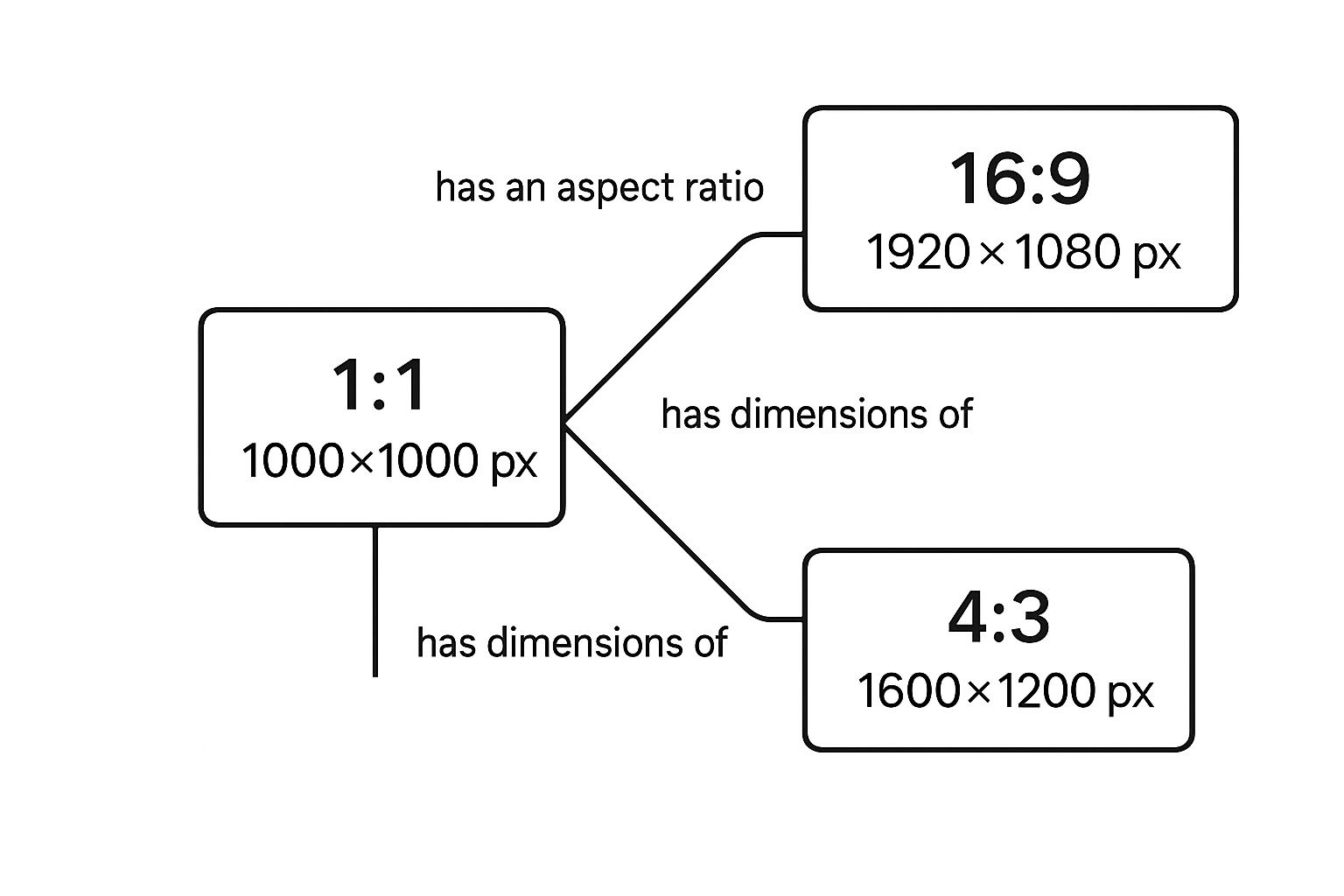
As you can see, the 4:3 ratio gives you that classic rectangular shape that’s perfect for most product shots.
Getting a handle on these basics is a game-changer for your Etsy shop, but these principles apply everywhere online. If you're looking to level up your visuals across the board, checking out a comprehensive social media post dimensions guide can be incredibly helpful.
A Step-By-Step Guide to Resizing Your Photos
Knowing the ideal Etsy product photo size is one thing, but actually getting your images to that size is another beast entirely. The good news? You don't need a degree in graphic design to get this right. Let's walk through how to resize your photos using a couple of popular and easy-to-use tools.
The whole point is to hit Etsy’s recommended size—at least 2000 pixels on the shortest side—without making your product look squished or stretched. Think of it like tailoring a suit. You want a perfect fit, not one that pulls awkwardly at the seams. To do this, you need to lock the aspect ratio, which keeps the photo's proportions intact while you scale it up or down.
Pretty much any photo editor you use will have a little "lock" icon or a checkbox right next to the width and height fields. Before you touch anything else, make sure that lock is on. It’s the golden rule of resizing.
Using Free Tools Like Canva
For a quick and painless resize, Canva is a fantastic choice. It’s incredibly user-friendly, making it perfect if you're not ready to dive into more complex software.
- Start a New Design: Open up Canva, click "Create a design," and select "Custom size."
- Enter Your Dimensions: Pop in your target dimensions. A great option is 3000px by 2250px, which gives you that perfect 4:3 ratio Etsy loves.
- Upload and Adjust: Upload your product photo and simply drag it onto the blank canvas. You might need to pull the corners to make it fill the frame, just be careful not to crop out any key details.
- Export the Right Way: When you're done, download the image as a JPG. To keep your file size under that crucial 1MB mark without losing too much quality, aim for a quality setting around 80-90%.
Using Professional Software Like Photoshop
If you're already using Adobe Photoshop, you have a bit more granular control over the final image, which is always a plus. The process is just as simple.
Pro Tip: Photoshop's "Save for Web (Legacy)" feature is your best friend here. It shows you a live preview of both the image quality and the final file size, so you can strike the perfect balance before you even hit save.
- Open Your Image: In Photoshop, head to
File > Export > Save for Web (Legacy). - Pick Your Format: Choose JPEG from the preset dropdown menu and set the quality to High or Very High (a value around 80 usually does the trick).
- Resize Your Image: Look for the "Image Size" section. Make sure the little chain link icon is active—that’s what locks your aspect ratio. Change the shortest side to 2000 pixels, and watch as Photoshop automatically adjusts the other dimension for you.
- Save It: Click "Save," and your photo is officially Etsy-ready.
And if you have a whole batch of photos to get through, a dedicated online image resizer can be a real lifesaver, handling all of them at once and saving you a ton of time.
Using All Ten Photo Slots to Tell a Story
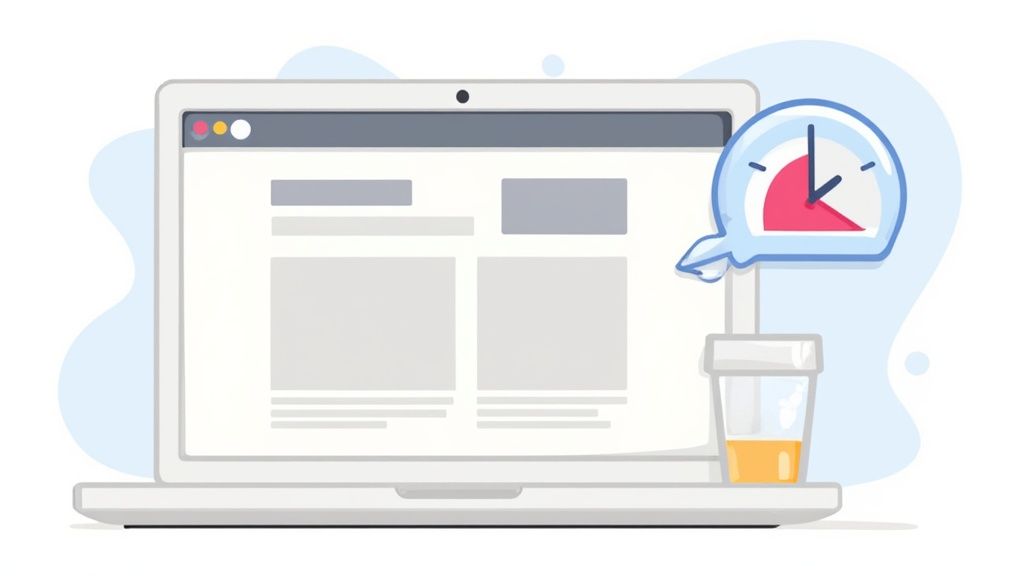
Etsy gives you ten photo slots for a reason, and if you're not using every single one, you're leaving money on the table. Seriously. Think of it less like filling a quota and more like telling a complete visual story—one that answers a customer’s questions before they even have a chance to ask them. A single photo can pique interest, but ten photos build trust and seal the deal.
Your first image is your hero shot. It has to be fantastic—crisp, well-lit, and clean. This is the photo that stops the scroll and gets people to click. But the real selling happens in the next nine slots. Each of those photos needs a specific job, working together to show a potential buyer everything they need to know.
Your Strategic Photo Blueprint
This is how you overcome a shopper’s natural hesitation. By showing your product from every angle and in different contexts, you’re closing the gap between what they see on their screen and what they’ll hold in their hands. An informed customer is a confident customer, and confident customers click "buy."
A truly effective photo gallery should feel like a guided tour. Make sure you include:
- Every Angle: Show the front, back, and sides. Is it a locket? Show it open. A handbag? Let’s see the inside pockets. Leave no stone unturned.
- Juicy Close-Ups: Get right in there and capture the texture of the wood grain, the fine details of your brushstrokes, or the quality of your stitching. These shots are what justify your price and show off your skill.
- Lifestyle Shots: Help people picture your product in their world. A mug is just a mug until someone is cozied up on the couch holding it. A print is just a file until it’s hanging on a beautifully styled wall.
- Sense of Scale: This one is huge. Place your item next to something familiar—a hand, a coin, a coffee cup—to give an instant, intuitive feel for its actual size.
Pro Tip: Let's be honest, many shoppers skim or completely skip the product description. Your photos have to do the heavy lifting, visually communicating size, texture, and use without relying on a single word of text.
Think about it this way: if you're selling a handmade ceramic pot, you'd show a crisp shot of the pot on its own. Then, a close-up of the glaze's texture, another photo of you holding it to show the scale, one with a small plant inside, and maybe even one showing your branded packaging. Each image answers a potential question, walking the shopper straight to the “Add to Cart” button.
Why Etsy's Image Standards Keep Changing
If you’ve been selling on Etsy for a while, you've probably noticed that the "perfect" product photo size seems to change every few years. It’s not just to keep you on your toes. These updates are a direct reflection of how we all shop and the devices we use every day.
Think back just a decade ago. Most of us were browsing on smaller, lower-resolution screens with much slower internet. The photos didn't need to be huge. But now? Your customers are looking at your products on everything from massive, crystal-clear desktop monitors to the incredibly sharp screens on their phones. To make your products look fantastic on all of them, Etsy had to adapt.
The Big Picture: Etsy's changing image requirements aren't just random rules. They're a response to massive shifts in technology and shopper behavior, all designed to make sure your products look incredible on the modern web.
The history of Etsy’s own guidelines tells this story perfectly. Years ago, the platform's minimums were much smaller, hovering around 635 pixels. But as high-resolution screens and mobile shopping took over, those recommendations grew. Now, Etsy suggests aiming for at least 2000 pixels on the shortest side of your image. This isn't an arbitrary number; it's what's needed to guarantee your photos stay sharp and clear, even when a customer zooms way in. You can learn more about these historical shifts to see just how far we've come.
Understanding this background is key. Keeping up with new image standards isn’t just a technical chore—it’s a smart business move that keeps you competitive and meets your customers' expectations. It also drives home why investing in quality photos matters so much. If you're exploring that path, getting a sense of the cost of professional product photography can help you decide how to best present your work.
Common Questions About Etsy Photo Sizes
Let's be honest, figuring out the exact image rules for any platform can feel like a guessing game. To help you skip the trial and error, I've gathered some of the most common questions I hear from Etsy sellers and answered them directly.
What Are the Best Dimensions for an Etsy Listing?
Etsy's official recommendation is a minimum of 2000 pixels on the shortest side. That's a good starting point, but if you want to really impress, I suggest aiming higher. A size like 3000 x 2250 pixels is the sweet spot.
Why? Because it not only gives you incredible detail for Etsy's zoom feature, but it also perfectly fits their preferred 4:3 aspect ratio. This ensures your photos look sharp and professional across the board, from big desktop screens to tiny mobile phones.
Are All Etsy Photos Square?
Nope, but the most important one is. Your main product photo—the one that shoppers see first in search results and on your shop's homepage—is automatically cropped into a square thumbnail. The dimensions for this preview are 570 x 456 pixels.
This is precisely why sticking to a 4:3 or 1:1 (square) aspect ratio for your primary image is so important. It gives Etsy a clean, predictable area to crop from, preventing your product from being awkwardly cut off. You have more creative freedom with the other nine photo slots.
Key Takeaway: Always use a horizontal (landscape) or square photo as your main listing image. A vertical (portrait) photo will almost certainly get cropped in a way that hurts its appearance in search results, and that can cost you valuable clicks.
Can I Use My Phone to Take Good Photos?
You absolutely can! The camera on your smartphone is a powerful tool, more than capable of taking photos that meet and exceed Etsy's standards. I've seen countless successful shops built entirely on smartphone photography.
The secret isn't a high-end DSLR; it's about technique. Focus on getting great lighting (natural light is your best friend), keeping your phone steady with a simple tripod, and making a few basic edits for brightness and contrast. Just be sure to set your phone's camera to its highest quality setting before you start shooting.
Tired of wrestling with complicated editing software? With ProdShot, you can transform basic phone pictures into stunning, high-converting product photos in just a few clicks. Try ProdShot for free and see for yourself how simple it is to level up your Etsy shop's look.
Subscribe to my newsletter
Read articles from ProdShot Creator directly inside your inbox. Subscribe to the newsletter, and don't miss out.
Written by
